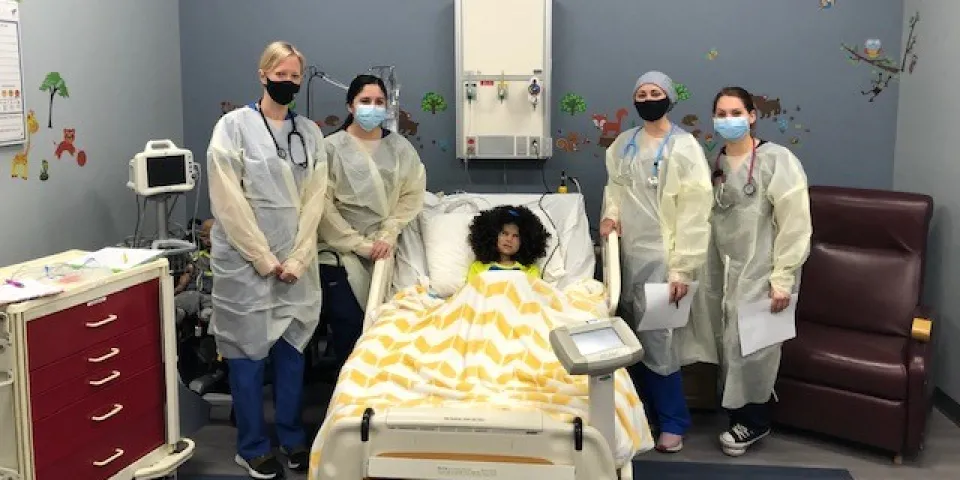Latest 
 Career Development Denise Alexander
Career Development Denise Alexander
Recent Blog Posts


Not surprisingly, the demand for nurses has been exacerbated by the pandemic. To keep up with the growing demand, the ways nurses are trained have subsequently adapted. Nursing students prepare for a variety of clinical situations in their classroom, but it’s no longer just through textbooks!
Nursing simulation labs (SIM labs) provide a transition from classroom learning to clinical training. SIM labs allow nursing students to apply theoretical principles of nursing care in a safe hands-on learning environment.
Not all SIM labs look the same. Allison Banach, MSN, BSN-RN shares some of the unique features of Herzing University-Brookfield.
The Herzing University-Brookfield lab is not your typical SIM lab! The students who step foot into the SIM lab also step into the role of the nurse taking care of patients. They get to practice across a variety of patient populations and health conditions, whether it be a focus on mental health or medical-surgical nursing and beyond.
The SIM lab isn’t a single room with a CPR mannequin. At Herzing University-Brookfield, students have access to three different simulation labs. There is a high-fidelity pediatric simulator, an adult simulator, and an OB simulator. This OB simulator can change from a standard adult to a patient who can give birth in the labor and delivery center.
The simulation labs give Nursing students a variety of opportunities to practice clinical skills and critical thinking in a variety of patient scenarios.
A common misconception is that nursing students are unguided in the SIM lab. Although they are practicing the skills they have learned, students are given plenty of direction before, during and after they enter the SIM lab.
At the start of each simulation, students complete a pre-brief session. Students come prepared and understand the health condition of focus and medications that pertain to the simulation. During the pre-brief, there is an in-depth discussion and videos that pertain to the health condition. This will help students gain greater insight and understanding of their role as nurses.
Students then transition into the simulation. Everyone is encouraged to participate and play an active role in caring for the patient. This role and the time spent in the SIM lab can change depending on the situation.
After the simulation is completed, the students participate in a debrief session. They are encouraged to think about what they did well and something they can improve on in future nursing practice. Lastly, students reflect on what they learned from the simulation.
Our goal is to have students walk away from the simulation more confident and competent in their role as a nurse in patient care.
All nursing students use the three clinical nursing to practice and check off on their clinical and physical health assessment skills.
“We have an open lab for students to come and practice, which aids in working with work-life-school-balance,” Banach described, “We have experienced, enthusiastic, and knowledgeable Lab Nursing Faculty who aid the students in their clinical and physical health assessment nursing competency skills.”
The amount of time that nursing students spend in the lab varies. Practical Nursing (LPN) students in the diploma program have more of an expedited program, in which they have a shorter period to complete their courses. Their skills vary slightly from Bachelor of Science in Nursing (BSN) students. In these programs, there are additional skills that they need to learn as part of their scope of standards and practice.
Students and faculty enjoy the simulations, as they give the students a different opportunity to focus on a problem or concern, think critically, and learn the importance of autonomy and teamwork in Nursing.
The future of simulation education continues to advance, in encouraging students to interact more and to challenge their current nursing thought processes to aid in their preparedness for their future nursing practice. There are continuing advances in simulation technology that enables students to interact more with the patient experience and put all the puzzle pieces together.
BLS pay estimates calculate the median annual wage for various occupations. Per the BLS the median wage for an occupation is: "The wage at which half of the workers in the occupation earned more than that amount, and half earned less. Median wage data are from the BLS Occupational Employment and Wage Statistics survey." Bureau of Labor Statistics (BLS), U.S. Department of Labor, Occupational Outlook Handbook 2024. BLS median wage estimates do not represent entry-level wages and/or salaries. Multiple factors, including prior experience, age, geographic market in which you want to work, and degree level and field, will affect career outcomes, including starting salary and earnings as an experienced employee. Herzing neither represents that its graduates will earn the median salaries calculated by BLS for a particular job nor guarantees that graduation from its program will result in a job, promotion, particular wage or salary, or other career growth.
Get the latest news you need to know, from study hacks to interview tips to career advancement. Have it delivered right to your inbox biweekly.